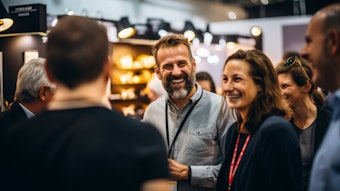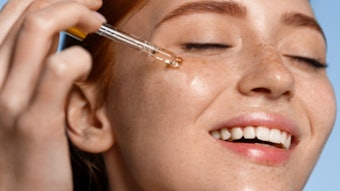Report courtesy of Cosmetics & Toiletries magazine.
Although the aisles of the New Munich Trade Fair Centre in Munich, Germany, were less crowded for in-cosmetics 2009, attendees were more focused, driven and dedicated to their goal of absorbing information about cosmetic formulating in the 21st century.
As attendees swarmed in to the event’s gates on April 21, 2009, they were greeted with traditional alphorn players. Afterward, various members of the press gathered in the international guest reception room for a panel discussion on the impact of the global economic turmoil on the beauty industry.
The panel discussion was led by Heide Hildebrand, head of beauty and health at InStyle Germany. Panel members also included Sian Sutherland, co-founder of Mamma Mio; Nicole Stollenwerk, partner at KPMG Cologne; and Richard Hesk, group exhibition director for in-cosmetics. The members had a number of insights into the current state of the beauty care market. According to Stollenwerk, although the body care market is quite flat with a gain of only 2% in 2008, decorative cosmetics has seen a large growth with a 7% gain in 2008. She added, “75% of consumers say they are not cutting down while 25% of consumers will shop more. However, many consumers report they will become more price sensitive.” Hesk added that while the market is flat, there seems to be optimism in the ingredients market as there has been growth in the end of 2008. Sutherland found that the recession is an opportunity for small brands to grab market share as being nimble is necessary in a recession. Sutherland advised product manufacturers to stop thinking as a brand and start thinking as a woman. For 2009, she encouraged brands to question everything, to innovate, to be realistic and to, above all, be transparent. Stollenwerk added that naturals will become increasingly popular in 2009 and Sutherland agreed, adding that wellness goes up in times of a recession. “This is a time of foundation, as women want flawless complexions,” added Sutherland. In terms of retail channels, Sutherland’s online business has been growing, and she believes that brick-and-mortar retail is going to suffer. Stollenwerk agreed, adding that products purchased though home shopping networks is growing in popularity.
The education at the exhibition continued with in-focus 3d. The theme for 2009 was Designing Beauty Architecture, which was highlighted at the in-focus’ workshop program. Bruno Bernard, head of hair biology group, advanced research, life sciences direction at L’Oréal; and Frédéric Leroy, head of the department of physics, advanced research, direction of material science at L’Oréal, led the workshop titled “Architecture of Skin and Hair, for Irrefutable Proof of Efficacy in Cosmetics.”
Bernard introduced both transcriptomics and proteomics, two processes that he found complementary to study the skin. According to Bernard, “Through transcriptomics and proteomics, genuine bar codes can be assigned to skin conditions.” He added “If you want to study skin as a whole, you have to look at the living and the dead parts.” He explained that transcriptomics can assign a specific response signature to skin surface aggression in reponse to mechanical stress. Though transcriptomics, his team has discovered that old skin heals differently than young skin, and that a 25 gene signature characterizes the difference in response. Conversely, proteomics assigns a specific signature to the stratum corneum (SC). The SC is comprised of nearly 700 proteins, and this process can identify protein signatures specific to young and old skin.
Furthering the discussion of skin structure was Leroy, who discussed two-photon microscopy. According to Leroy, “No medical imaging can reveal skin structure on a molecular level, and although biopsy could, it is too invasive.” Two-photon miscroscopy is a non-invasive biochemical analysis that provides dynamic information and three-dimensional images on a subcellular scale using infrared light. Leroy went on to express that the main advantage of the microscope is that you can look at the dermis. With infrared light, collagen and elastin shine and the third structure of the protein network is revealed. Leroy added, “You can use it in vivo to see aging in the skin, including morphological and structural changes.”
The in-focus 3d stand featured the beauty innovation of a number of raw material suppliers. At this technological exhibition, Symrise presented the architecture of a fragrance through a pyramid diagram of fragrance notes. The fragrance began with a green hazelnut accord top note followed by an edible base note and a fruity middle note. This “next generation of nonalcohol fragrance” was demonstrated through a computerized scent box that emitted the designed fragrance for attendees to smell throughout the presentation. The company also demonstrated its process to create pearls for a personal care product in which a microemulsion was dropped into water. For Croda’s presentation at in-focus, it was all about the lips, as it explained the structure of lipstick and lip gloss in addition to the changing structure of the lips. According to its presentation, it used three standard waxes and changed the combination of 90% oils to product different oil/wax interaction.
Continuing the innovative product discussion was Mintel at its Innovation Zone. Nica Lewis, head consultant at Mintel Beauty Innovation, held a demonstration of some of the finished products she found to be innovative. These included products that utilized textured packaging, were formulated with interesting ingredients such as pheromones, and imparted unique texture. Behind the demonstration table were a number of raw material launches displayed at the stand in addition to many innovative finished products. The categories of finished products included techno beauty, naturals, protection and antiaging. Featured products, to name a few, included Sovage’s Tummy Flatening Gel, a transdermal gel formulated to reduce abdominal fat through precise delivery of its Epidril base formulation featuring aminophylline; RevGenetics’ Sirtuin Skin, a combination of resveratrol, acetyl hexapeptide-3, palmitoyl pentapeptide-3 and sodium hyaluronate to help fight the appearance of fine lines; and Chanel’s Ultra Correction Repair line, designed to firm and lessen the appearance of wrinkles.
Leading technologies for advanced skin care was not only a focus in the Innovation Zone, but also at the in-focus feature on the show floor where the topic of “3d” was explored. For example, Marie Seigneur, PhD, scientific development director for Chanel Research and Technology, described research from an architectural angle. Tensegrity is the property of skeletal structures to employ tension and compression to maximize efficiency and economy in an entity. She drew a parallel to this architectural phenomenon to the relationship between skin and bones, and how this relationship changes with aging.
“Tension and compression balance biological cells and make them active,” said Seigneur. “Without tension, cells die.” She described one major focus of the company’s work as examining integrins, which link cells to the matrix, in addition to tensin in fibroblasts, an intracellular protein that is important for adhesion and to maintain tension in the skin. “We now know what to do [with these biological factors],” said Seigneur, “but now we need to find a molecule or active that will do it.”
While some innovations have pushed the industry toward a concept of techno beauty, others remain firmly rooted in naturals and organics. In fact, a vast majority of suppliers at the show focused efforts on re-launching bio-derived or eco-friendlier versions of former ingredient offerings. Botanicals were highlighted to enhance products with a sense of well-being, and materials such as natural cherry powder and dried palm tree milk powder sparked interest as novel sources for natural materials.
Within this natural vein, the representation of two particular firms at in-cosmetics was interesting. NaTrue, a natural and organic certification group out of Brussels, was present to describe its approach to labeling simply as “the truth” about ingredients. According to Vincent Letertre of the group’s scientific committee, “We do not view parabens as ‘bad,’ we just acknowledge that they are not natural.” Letertre added that some ingredients are necessary in formulations to ensure efficacy and safety, and the group considers this fact in its labeling requirements.
Minimum and maximum levels for ingredients are set per product category and classed in a 1-3 star rating system, including: genuine natural cosmetics, natural cosmetics with organic ingredients, and organic cosmetics. “We strive to be transparent,” explained Julie Tyrrell, secretary general for the group, “Consumers expect that materials labeled as natural are in fact natural.” To which Letertre added, “Half-truths are not sustainable.”
Looking ahead, the Union for Bioethical Trade presented on the next wave in the naturals segment: biodiversity. According to the group, with so many industries focused on natural materials, questions about the preservation of ecosystems from which they are derived are raised. In a new study of 4,000 consumers in France, Germany, the U.K. and the U.S., one out of two consumers said they had heard of biodiversity, and 85% of study respondents said they wanted to know more about how companies in the cosmetics sector source their natural ingredients. Rik Kutsch Lojenga, executive director for the union, explained, “While consumers have heard of biodiversity, they are just beginning to understand what it means.” He added that as they become more educated, consumers will seek natural products that maintain the natural ecosystem. “The year 2010 will be the year of biodiversity.”
Naturals were also discussed by Gillian Morris, director at chemicals and materials practice for Kline & Company in her marketing presentation, “Innovative and Enabling Technologies in Personal Care—Future Outlook.” According to Morris, the countries seeing double digit growth in personal care are Argentina, India, Brazil, China and Russia. She noted that the demarcation between the nutrition, pharmaceutical and cosmetic industries is blurring. Delivery systems, according to Morris, are a distinct innovation area that include nanoparticles, microencapsulation, microsponges, patches and films. Of the many different delivery technologies, Morris highlighted the “stay put technologies” or patches as particularly innovative and of interest for future innovators. Morris also highlighted the raw materials used in innovation in 2008 including: vitamins A, C, E, and K; enzymes; alpha lipoic acid; peptides; biopolymers; botanical actives; skin-lightening actives; and proteins. Within proteins specifically, Morris found that the conversation was moving from animal-based proteins to synthetic proteins. Botanical actives mentioned included green tea, chamomile, bisabolol, grape seed and kinetin. Skin-lightening actives included arbutin, azaelic acid, kojic acid, magnesium ascorbic acid and tretanoin. According to Morris, “Enabling technologies in the future will come from a variety of places including drug development, chemical engineering, wound care, chemical polymer science and food. In the future, Morris envisions that innovation will take place in hormonal creams, boosters, improved deposition for oral care, preventing irritation and hair styling polymers.
The exhibition will take place in Paris in 2010, and the organizers named Milan as the location for in-cosmetics in 2011.










